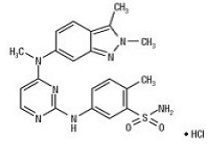Pazopanib

Votrient is a targeted therapy. Votrient is classified as a Tyrosine Kinase inhibitor; Vascular Endothelial Growth Factor (VEGF) inhibitor. Votrient is used for the treatment of advanced renal cell carcinoma.
The recommended starting dose of VOTRIENT is 800 mg orally once daily without food (at least 1 hour before or 2 hours after a meal). The dose of VOTRIENT should not exceed 800 mg. Do not crush tablets due to the potential for increased rate of absorption which may affect systemic exposure. If a dose is missed, it should not be taken if it is less than 12 hours until the next dose.
Votrient is not a chemotherapy drug but one of many "targeted therapies." Targeted therapy is the result of about 100 years of research dedicated to understanding the differences between cancer cells and normal cells. To date, cancer treatment has focused primarily on killing rapidly dividing cells because one feature of cancer cells is that divide rapidly. Unfortunately, some of our normal cells divide rapidly too, causing multiple side effects. Targeted therapy is about identifying other features of cancer cells. Scientists look for specific differences in the cancer cells and the normal cells. This information is used to create a targeted therapy to attack the cancer cells without damaging the normal cells, thus leading to fewer side effects. Each type of targeted therapy works a little bit differently but all interfere with the ability of the cancer cell to grow, divide, repair and/or communicate with other cells. Votrient is designed to block tumor cell growth in several ways. Votrient targets several proteins (called tyrosine kinases) on the surface of cancer cells, as well as targets within the cell. Several of these targets are thought to be involved in angiogenesis (making of blood vessels). By blocking these targets, it is hoped the cancer will shrink.
Pazopanib is a multi-tyrosine kinase inhibitor of vascular endothelial growth factor receptor (VEGFR)1, VEGFR-2, VEGFR-3, platelet-derived growth factor receptor (PDGFR)-α and -β, fibroblast growth factor receptor (FGFR)-1 and -3, cytokine receptor (Kit), interleukin-2 receptor-inducible T-cell kinase (Itk), leukocyte-specific protein tyrosine kinase (Lck), and transmembrane glycoprotein receptor tyrosine kinase (c-Fms). In vitro, pazopanib inhibited ligand-induced autophosphorylation of VEGFR-2, Kit, and PDGFR-β receptors. In vivo, pazopanib inhibited VEGF-induced VEGFR-2 phosphorylation in mouse lungs, angiogenesis in a mouse model, and the growth of some human tumor xenografts in mice.
Important things to remember about the side effects of Votrient:
-
Most people will not experience all of the Votrient side effects listed.
-
Votrient side effects are often predictable in terms of their onset, duration, and severity.
-
Votrient side effects are almost always reversible and will go away after therapy is complete.
-
Votrient side effects may be quite manageable. There are many options to minimize or prevent the side effects of Votrient.
Common (occurring in greater than 30%) Votrient side effects include: diarrhea, hypertension, hair color changes, low blood counts (low white blood cells, low platelets), elevated liver function tests (AST, ALT), elevated bilirubin level, and blood test abnormalities (low phosphorus, low sodium, increased glucose).
Less common (occurring in 10-29%) Votrient side effects include: nausea, vomiting, poor appetite, fatigue, weakness, abdominal pain, headache, and blood test abnormalities (low magnesium, low glucose-low blood sugar).
